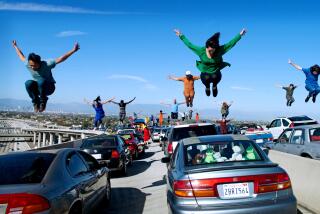A Standoff at Otay Lake : Plans for an Olympic training center at the reservoir has hunters and fishermen worried that they will be pushed out of their haven.
L. Kevin Mineo, a San Diego attorney who loves to fish, firmly believes that hunters, fishermen and sail boarders can coexist with the rowing, canoeing and kayaking training facility that the San Diego National Sports Training Foundation has proposed at Lower Otay Lake Reservoir.
But Mineo, who has pulled many trophy-sized fish from Otay, worries that the nonprofit foundation is really trying to wrest control of the lake from thousands of hunters, fishermen and sail boarders who use the lake for recreational purposes.
“The (training facility) could eliminate use by current recreational users of the facility,” according to Mineo, president of the San Diego Council of Bass Clubs, and a member of lake-use advisory groups formed by the city and state. “The uniqueness of the recreational opportunity currently afforded by Lake Otay cannot be overemphasized.”
George Hanson, an adjunct lecturer at UC San Diego who hunts ducks during the winter season at Otay, said that the proposed facility “scares the dickens out of me . . . they want the lake 365 days a year from sun-up to sun-down.”
“I am opposed to any Olympic training facility that will impact adversely on the general public,” Hanson said. “I’m against any training facility that will harm the environment. I’m opposed to the city essentially giving away its store to what amounts to a bunch of buccaneers coming in.”
Proponents argue that the boathouse, docks and training course designed to serve
Olympic-level athletes would not supplant the sports fishermen and hunters who have largely had Otay, a man-made reservoir, to themselves since the early 1900s.
“We understand we have to fit in with existing uses,” said David C. Nielsen, executive vice president of the San Diego National Sports Training Foundation, the nonprofit organization that has proposed the boating facility. “That’s been our commitment since the start.”
Nielsen maintained that it is too early for critics of the proposed boathouse, docks and training course to draw negative conclusions.
“We’re just beginning to prepare the environmental impact report, and more importantly, the preliminary operating plan that we would offer to the city for review,” Nielsen said.
Preliminary plans call for the Otay Lake facility to open in 1993. The city only recently began negotiations with the foundation to determine if a lease can be arranged, according to the city manager’s office.
The proposed boathouse, docks and a permanent rowing course on Otay Lake are part of a larger Olympic-training center that the San Diego-based foundation hopes to build in San Diego. On Saturday, members of the U.S. Olympics Committee Board of Directors attended groundbreaking ceremonies for the proposed multi-sport training complex that the foundation is building on a nearby, 150-acre tract.
The center, described by the foundation as the nation’s “first warm-weather, year-round location,” would join Olympics-class training centers previously established by other nonprofit groups in Colorado Springs and Lake Placid, N.Y.
Mineo and Hanson said that hunters and fishermen are not opposed to the 150-acre center near Lake Otay that will include a 20,000-square-foot visitors center, housing for at least 300 athletes, dining facilities, a large gymnasium, nine natural and artificial-surface playing fields and a 50-meter field.
The sportsmen also acknowledge that they’re not dead set against the Otay Lake project, which, according to preliminary plans, would include 10,000 to 15,000-square-foot boathouse, three or four docks and a 2,000-meter course on Lake Otay that athletes would use for training.
What they do oppose are some of the proposed changes in the lake’s appearance and the possibility that the Olympic training center will force the city to further limit public access to the lake.
Limited public access has long been a fact of life at Otay Lake, a city reservoir which is internationally known for its fishing and a preferred location for the area’s duck hunters.
The city opens the lake--which serves primarily as a city reservoir--for hunting and fishing an average of 130 days each year
Fishing is allowed from mid-January through mid-October on Wednesdays, Saturdays and Sundays. Hunters are allowed to use the facility on certain days during the winter. Sail boarding is also allowed, and picnickers and hikers use its shorelines.
Because of the use constraints, fishermen line up 24 hours ahead of time so they can launch their boats, according to Terrence Curren, chairman of the city’s Community Lakes Committee, which advises the city on lake-usage matters.
During the 108 days that the lake was open for fishing during the past year, the city issued 25,000 fishing permits, according to Jim Brown, manager of the city’s lakes program. About 1,000 hunting permits were sold during the 26 days when hunting was allowed.
Some outdoors enthusiasts believe that the Olympics training center should make do with the 230 days that the lake is not used by fishermen and hunters.
But “the Olympics group wants 365 day-year use, which is of course going to impact” on hunters and fishermen, Curren said. “Obviously there has to be compromise.”
“There’s obviously concern whether the (different) activities can coexist,” Curren said. “I have my doubts that duck hunters can coexist with rowers.”
“If you had 365-day usage and were to lose five days, it’s not that big of deal,” Curren said. “But if you only have 130 days and you lose a portion of that, it becomes a much more significant problem.”
Nielson said that splitting use by days would create a “logistical nightmare” because athletes would have to move their shells, canoes and kayaks to other locations on days when Otay Lake is closed.
That arrangement “is not acceptable, it wouldn’t work,” Nielson said. “We have to find some way to see if (all parties) can coexist.”
Curren suggested that city council, which will have the final say on the matter, will need to muster the wisdom of Solomon in order to divide the waters equitably. He suggested that, after discussion, fishermen and athletes might find that the lake is big enough to allow joint use by both groups.
However, the city’s lakes-use committee on Wednesday urged the city council to adhere to a 1986 recreation development plan that, in essence, calls for no interruption of the public’s use of the city’s lakes and reservoirs, Curren said.
Mineo said that the San Diego Council of Bass Clubs postponed a planned demonstration at the Olympic foundation’s Saturday groundbreaking.
“My understanding that there will be people there from all over the world, and that our demonstration might get in the way of Atlanta, which is pitching for the Olympics,” Mineo said last week before the groundbreaking. “A demonstration might harm them more than it would help us, and we like the Olympics.”
“I like the Olympics, too,” Curren said. “The whole thing is a real dilemma.”
More to Read
Sign up for Essential California
The most important California stories and recommendations in your inbox every morning.
You may occasionally receive promotional content from the Los Angeles Times.










